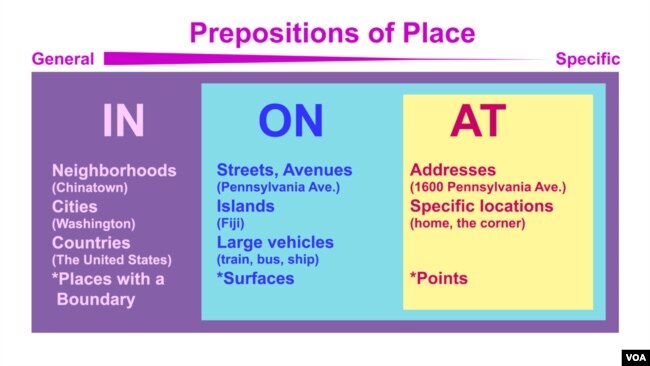Hello! This week we answer a question from Sajador.
Question:
I have a question about when we use “in,” “on” and “at.” I don’t know when to use them.
Thank you.
Sajador.
Answer:
Dear Sajador,
Thank you for writing to us. These little words cause a lot of trouble for English learners. They are called prepositions. One purpose of prepositions in English is to show the relationship between two or more things in time or place. These three words do follow some basic rules. It may be easier to think of them separately. Let’s begin with location, or place.
Prepositions of place
The first rule is to think of whether the place is general or exact. Here is an example of a general place, a city:
I live in Washington, DC.
We use “in” with cities, countries, neighborhoods, and places with a clear boundary or dividing line. Now, let us add some detail with our next example:
I live on Pennsylvania Avenue in Washington, DC.
This shows that you can use “on” for streets. We are moving from the general – a city – to a more specific location – a street. If we add the intersection, or cross street, we are adding more detail, that is, we are talking about an exact location and we must use “at.”
I live at the corner of 16th Street and Pennsylvania Avenue in Washington, DC.
Now you know the exact place the speaker lives and can guess that it might be the U.S. President, who lives at 1600 Pennsylvania Avenue!

Prepositions of time
When you want to talk about a time something happens, you can also use “in,” “on,” and “at.” I have a friend who is getting married soon. I can begin talking about the event this way.
Caroline’s wedding is in September.
I use “in” because this is general information. Use “in” for months, years, and parts of days, such as morning or afternoon. Getting more specific, I can use “on” and the day of the week.
Caroline’s wedding is on Saturday, September 24.
Finally, we can add the time, and use “at.”
Caroline’s wedding is on Saturday, September 24 at 1:00 pm.
I hope this helps you to use these little words with more confidence, Sajador. Just remember them in order (in-on-at) and that they help you go from general to exact information.

What question do you have about American English? Send us an email at learningenglish@voanews.com
And that’s Ask a Teacher.
I’m Jill Robbins.
And I’m Andrew Smith.
You can see more examples in the video below and the pictures showing the prepositions and their uses.
Dr. Jill Robbins wrote this lesson for VOA Learning English.
____________________________________________
Words in This Story
boundary – n. any line or thing marking a limit, bound or border
specific – adj. precise; definite; explicit
intersection – n. a place where roads or other lines meet or cross.
corner – n. a point or an area where two or more streets, sides, or surfaces of something join
confidence –n. a feeling of belief that you can do something correctly
